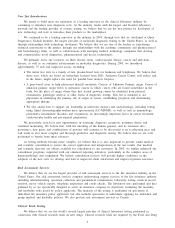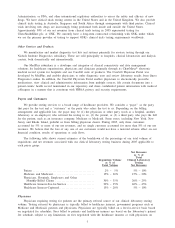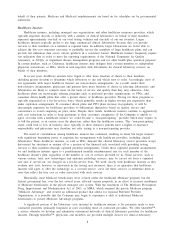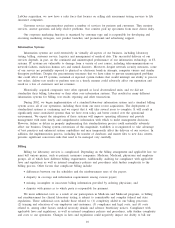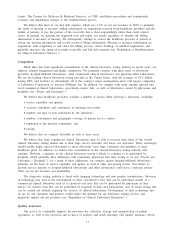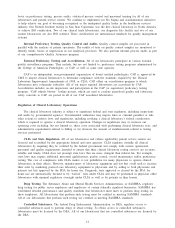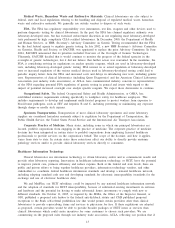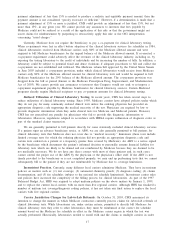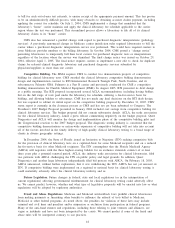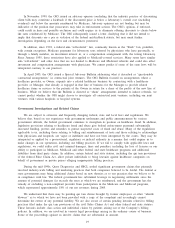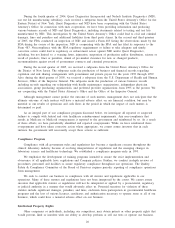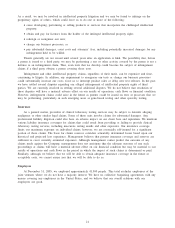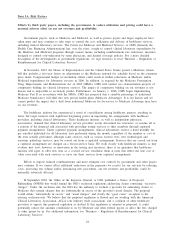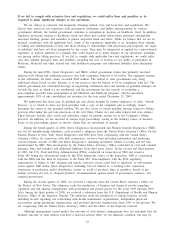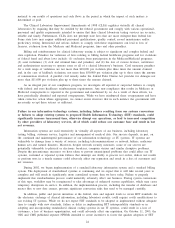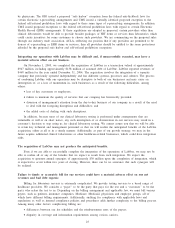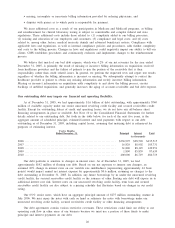Quest Diagnostics 2005 Annual Report Download - page 33
Download and view the complete annual report
Please find page 33 of the 2005 Quest Diagnostics annual report below. You can navigate through the pages in the report by either clicking on the pages listed below, or by using the keyword search tool below to find specific information within the annual report.November 21, 2005, CMS published its Final Physician Fee Schedule Rule (effective January 1, 2006) but did
not implement any changes to the Practice Expense values in the new fee schedule, leaving the lower
reimbursement for flow cytometry in place for 2006. In addition, the formula used for RBRVS calls for a 4.4%
reduction in the 2006 payment level for physicians services, including anatomic pathology services payable to
clinical laboratories. In February 2006, Congress eliminated the 4.4% reduction in the 2006 Physician Fee
Schedule, keeping the reimbursement for physician services (including anatomic pathology services billed by
clinical laboratories) unchanged from 2005. Approximately 1% of our net revenues are derived from pathology
services reimbursed by Medicare based on RBRVS.
With regard to the clinical laboratory services performed on behalf of Medicare beneficiaries, we must bill
the Medicare program directly and must accept the carrier’s fee schedule amount as payment in full. In
addition, state Medicaid programs are prohibited from paying more (and in most instances, pay significantly
less) than Medicare. Major clinical laboratories, including Quest Diagnostics, typically use two fee schedules for
tests billed on a fee-for-service basis:
•“Client’’ fees charged to physicians, hospitals, and institutions for which a clinical laboratory performs
testing services on a wholesale basis and which are billed on a monthly basis. These fees are generally
subject to negotiation or discount.
•“Patient’’ fees charged to individual patients and third-party payers, like Medicare and Medicaid. These
fees generally require separate bills for each requisition.
The fee schedule amounts established by Medicare are typically substantially lower than patient fees
otherwise charged by us, but are sometimes higher than our fees actually charged to certain clients. During
1992, the OIG of the HHS issued final regulations that prohibited charging Medicare fees substantially in excess
of a provider’s usual charges. The laboratory industry believes that the term “usual charges’’ specifically applies
to amounts charged to similarly-situated third-party payers and to patients and that client fees should not be
included in “usual charges’’. The OIG, however, declined to provide any guidance concerning interpretation of
these rules, including whether or not discounts to non-governmental clients and payers or the dual-fee structure
might be inconsistent with these rules.
A proposed rule released in September 1997 would have authorized the OIG to exclude providers from
participation in the Medicare program, including clinical laboratories, that charge Medicare and other programs
fees that are “substantially in excess of . . . usual charges . . . to any of [their]customers, clients or patients’’.
This proposal was withdrawn by the OIG in 1998. In November 1999, the OIG issued an advisory opinion
which indicated that a clinical laboratory offering discounts on client bills may violate the “usual charges’’
regulation if the “charge to Medicare substantially exceeds the amount the laboratory most frequently charges or
has contractually agreed to accept from non-Federal payers’’. The OIG subsequently issued a letter clarifying
that the usual charges regulation is not a blanket prohibition on discounts to private pay customers.
In September 2003, the OIG published a Notice of Proposed Rulemaking that would amend the OIG’s
exclusion regulations addressing excessive claims. Under the proposed exclusion rule, the OIG would have the
authority to exclude a provider for submitting claims to Medicare that contain charges that are substantially in
excess of the provider’s usual charges. The proposal would define “usual charges’’ as the average payment from
non-government entities, on a test by test basis, excluding capitated payments; and would define “substantially
in excess’’ to be an amount that is more than 20% greater than the usual charge. We believe that the rule is
unnecessary for the clinical laboratory industry because Congress has already established fee schedules for the
services that the rule proposes to regulate. We also believe that the rule is unworkable and overly burdensome.
Through our industry trade association, we filed comments opposing the proposed rule and we are working with
our trade association and a coalition of other healthcare providers who also oppose this proposed regulation as
drafted. If this regulation is adopted as proposed, it could potentially reduce the amounts we bill and collect
from Medicare and other federal payers, affect the fees we charge to other payers, or subject the Company to
penalties for non-compliance, and could also be costly for us to administer.
The 1997 Balanced Budget Act permits CMS to adjust statutorily prescribed fees for some medical
services, including clinical laboratory services, if the fees are “grossly excessive’’. In December 2002, CMS
issued an interim final rule setting forth a process and factors for establishing a “realistic and equitable’’
payment amount for all Medicare Part B services (except physician services and services paid under a
prospective payment system) when the existing payment amounts are determined to be inherently unreasonable.
Payment amounts may be considered unreasonable because they are either grossly excessive or deficient. In
December 2005, CMS published the final rule clarifying that if CMS or a carrier determines that an overall
16


